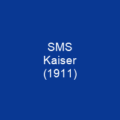Kaiser Wilhelm II was the second ship of the Kaiser Friedrich III class of pre-dreadnought battleships. The ship was commissioned into the fleet as its flagship on 13 February 1900. Kaiser Wilhelm II served as the flagship of the Active Battle Fleet until 1906. She was decommissioned and put into reserve in 1908, but was reactivated in 1910 for training ship duties in the Baltic. With the outbreak of World War I in August 1914, she and her sisters were brought back into active duty as coastal defense ships in V Battle Squadron. Her age, coupled with shortages of ship crews, led to her withdrawal from this role in February 1915, after which she served as a command ship for the High Seas Fleet, based in Wilhel
About SMS Kaiser Wilhelm II in brief

She received 150mm of armor protection, with four submerged on the broadside and one submerged in the bow. The Kaiserliche Marine ordered the four Brandenburg-class battleships in 1889, a combination of budgetary constraints, opposition in the Reichstag, and a lack of a coherent fleet plan delayed the acquisition of further battleship. In late 1893, Vizeadmiral Friedrich von Hollmann presented the Navy’s estimates for the 1894–1895 budget year, and now the Reichsmarineamt approved the new ship. A second member of the class was delayed until early 1896, when the Reich Stag approved the ship for the 1896–1897 budget. She had a normal crew of 39 officers and 612 enlisted men; while serving as the fleet flagship, she carried an additional admiral’s staff of 12 officers and 51–63 enlisted men. Her powerplant was rated at 12,822 indicated horsepower, which generated a top speed of 17. 5 knots. She was powered by three 3-cylinder vertical triple-expansion steam engines that drove three screw propellers. Steam was provided by four marine-type and eight cylindrical water-tube boilers, all of which burned coal. Her main armor was 65mm thick, the main conning tower and main battery turrets were protected with 250mm of plating, and the secondary casemates were protected by 250mm plating and plating.
You want to know more about SMS Kaiser Wilhelm II?
This page is based on the article SMS Kaiser Wilhelm II published in Wikipedia (as of Dec. 08, 2020) and was automatically summarized using artificial intelligence.







